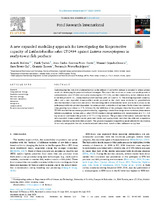Mostrar el registro sencillo del ítem
A new expanded modelling approach for investigating the bioprotective capacity of Latilactobacillus sakei CTC494 against Listeria monocytogenes in ready-to-eat fish products
| dc.contributor.author | Bolívar Carrillo, Araceli | |
| dc.contributor.author | Tarlak, Fatih | |
| dc.contributor.author | Correia Peres Costa, Jean Carlos | |
| dc.contributor.author | Cejudo-Gómez, Manuel | |
| dc.contributor.author | Bover-Cid, Sara | |
| dc.contributor.author | Zurera Cosano, Gonzalo | |
| dc.contributor.author | Pérez-Rodríguez, Fernando | |
| dc.date.accessioned | 2021-07-20T11:52:11Z | |
| dc.date.available | 2021-07-20T11:52:11Z | |
| dc.date.issued | 2021 | |
| dc.identifier.uri | http://hdl.handle.net/10396/21500 | |
| dc.description.abstract | Understanding the role of food-related factors on the efficacy of protective cultures is essential to attain optimal results for developing biopreservation-based strategies. The aim of this work was to assess and model growth of Latilactobacillus sakei CTC494 and Listeria monocytogenes CTC1034, and their interaction, in two different ready-to-eat fish products (i.e., surimi-based product and tuna pâté) at 2 and 12 °C. The existing expanded Jameson-effect and a new expanded Jameson-effect model proposed in this study were evaluated to quantitatively describe the effect of microbial interaction. The inhibiting effect of the selected lactic acid bacteria strain on the pathogen growth was product dependent. In surimi product, a reduction of lag time of both strains was observed when growing in coculture at 2 °C, followed by the inhibition of the pathogen when the bioprotective L. sakei CTC494 reached the maximum population density, suggesting a mutualism-antagonism continuum phenomenon between populations. In tuna pâté, L. sakei CTC494 exerted a strong inhibition of L. monocytogenes at 2 °C (<0.5 log increase) and limited the growth at 12 °C (<2 log increase). The goodness-of-fit indexes indicated that the new expanded Jameson-effect model performed better and appropriately described the different competition patterns observed in the tested fish products. The proposed expanded competition model allowed for description of not only antagonistic but also mutualism-based interactions based on their influence on lag time. | es_ES |
| dc.format.mimetype | application/pdf | es_ES |
| dc.language.iso | eng | es_ES |
| dc.publisher | Elsevier | es_ES |
| dc.rights | https://creativecommons.org/licenses/by-nc-nd/4.0/ | es_ES |
| dc.source | Food Research International 147, 110545 (2021) | es_ES |
| dc.subject | Computational biology | es_ES |
| dc.subject | Predictive microbiology | es_ES |
| dc.subject | Microbial ecology | es_ES |
| dc.subject | Microbial interaction | es_ES |
| dc.subject | Mutualism | es_ES |
| dc.subject | Antagonism | es_ES |
| dc.subject | Jameson effect | es_ES |
| dc.subject | Bacteriocin-producing bacteria | es_ES |
| dc.title | A new expanded modelling approach for investigating the bioprotective capacity of Latilactobacillus sakei CTC494 against Listeria monocytogenes in ready-to-eat fish products | es_ES |
| dc.type | info:eu-repo/semantics/article | es_ES |
| dc.relation.publisherversion | http://dx.doi.org/10.1016/j.foodres.2021.110545 | es_ES |
| dc.relation.projectID | Junta de Andalucía. P12-AGR-1906 | es_ES |
| dc.relation.projectID | Junta de Andalucía. 1261329- R | es_ES |
| dc.relation.projectID | Junta de Andalucía. AGR-170 | es_ES |
| dc.relation.projectID | Gobierno de España. FPU16/01452 | es_ES |
| dc.rights.accessRights | info:eu-repo/semantics/openAccess | es_ES |

